Macarons and Humidity
Hello friends, let’s talk about macarons and humidity.
It seems to be a lot of people’s idea that macarons and humidity don’t get along.
I am here to prove this idea wrong once and for all!
This post may contain affiliate links. I earn a commission from qualified purchases. Please read our Privacy policy here.
A few months ago I moved from upstate New York to sunny Florida. During winter, it gets pretty dry in New York, specially inside the house, because of the heat being on the whole time. Your skin gets dry, and so do your macaron shells.
We moved to Florida in the middle of summer time, when the weather is far from dry, it’s actually pretty hot and humid as you may have heard. I was a bit scared of the humidity to be honest, I wondered how it would affect my macaron shells.
This is what I learned after living in Florida for 3 months: I love baking macarons in the humid weather!
If you live in a place with humid weather and you are struggling with macarons, I am here to help you!
The humid weather is so much better for my macarons than the dry weather. During winter time in New York, my macaron shells were getting super dry and crunchy, I had to totally ditch the egg white powder when making macarons, and even after maturing for days in the fridge, the macaron would still be too crunchy when you bit into it.
In the humid weather, my shells just have the perfect consistency. They have the right amount of chew, they are delightful soft in the middle, and slightly crunchy to the bite! I am in love with the humid weather for macarons!

What is considered high humidity?
Let’s start by defining what would be high humidity. Anything over 50% is considered high humidity. Usually (not always) it’s more humid outside the house than inside. And for that reason it’s important to have a humidity sensor in your kitchen. I keep mine on the fridge. The other day it was 99% humidity outside (I checked on my weather app on my phone) but it was about 54% inside my house.
This is my humidity sensor.
The Humidity Sensor I use can be found on Amazon, it has become an essential tool for me when making macarons.
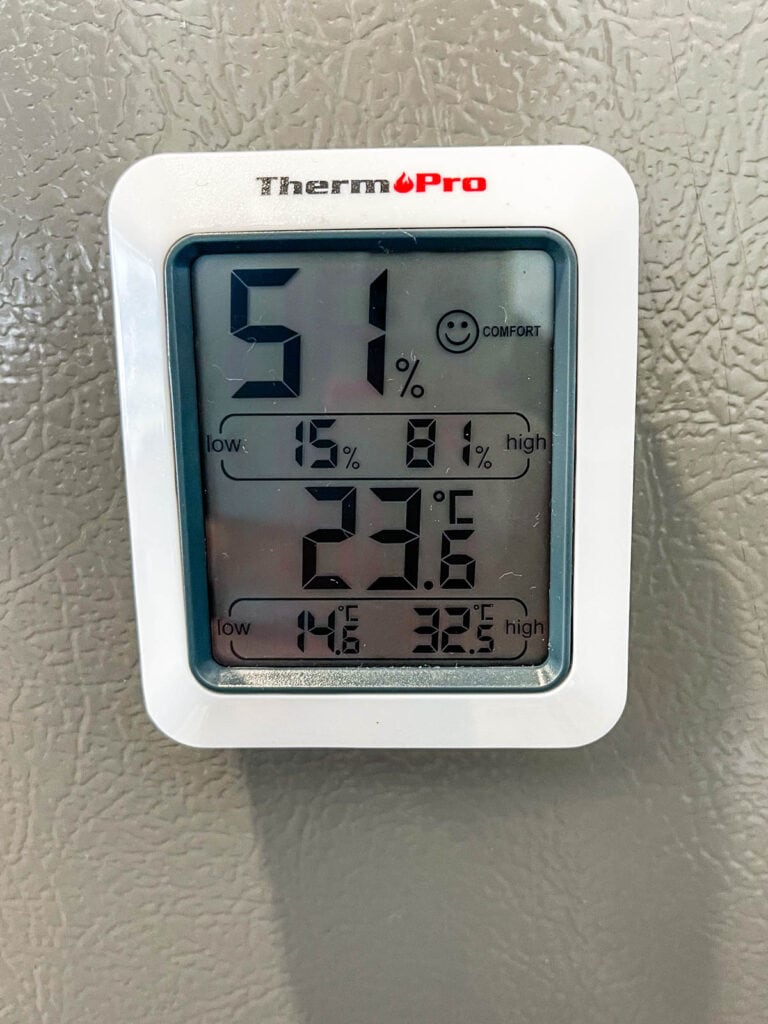
How does humidity affect macarons?
The way that humidity can affect macarons is in great part because of the presence of sugar.
Sugar is hygroscopic, which means it attracts and absorbs water particles. So basically if the environment you are in is high in humidity, the sugar particles in the macarons will draw moisture from the air.
This will not only affect the final texture of the cookies, but also the meringue, the consistency of the batter, resting time, and everything else, since we add sugar right in the beginning of the process.
Is that necessarily a bad thing? Not at all. You can totally make macarons in the humid weather, during the rainiest day.
The humid weather can affect whipping time, you may need to whip a bit longer, and you also may need to add a stabilizer to the meringue (we will get to it in a second).
Also, if the humidity is too high, the macarons won’t be able to dry during the “resting” process before baking, because instead of the air drying the macarons, the batter will draw moisture from the air. And in that case, the shells wouldn’t be able to dry properly, or they could crack in the oven.
Tips for baking macarons in high humidity
Let’s go over our options here. There are many things we can do to try and adjust to the humid weather, and of course thrive on it!
You can try a few of these, maybe even all of them. These are just suggestions, and some of the adjustments I have myself made in my kitchen. Remember that macarons work very differently for each individual, so it’s a matter or experimenting and finding out what is better for you.
Air Conditioner
The day I am making macarons, first thing I do is turn the air conditioner super cold a couple of hours before starting. Yes the house will be a bit chilly, but the ac will absorb moisture and warmth from the air, so that will already help with the air in the house to become less humid.
I understand not everyone has an air conditioner, which is fine, there are other options, let’s continue to explore them.
Fan
Fans are actually not going to reduce the humidity levels of your house, but they help the air circulate which can be helpful. And it can be specially helpful to let the macarons rest in a room with the ceiling fan on, because the air will blow gently on the macarons, which can help them dry.
If the humidity inside of your house is higher than the humidity outside of your house, you can place a fan on the window with the air blowing directly outside, this will pull the humid air from your house and expel it outdoors.
Dehumidifier
If you live in a humid climate, where for a large portion of the year it will be warm and humid, I recommend you get a dehumidifier. Depending on the size of the room you have, dehumidifiers can be pricey as you will need a more potent unit for a larger room. But they are very effective at reducing humidity.
The space where I bake is big, it has high ceilings, so I needed a powerful unit. With that unit I am able to reduce the humidity by even 10%, which is a huge help.
I turn the dehumidifier on a few hours before baking the macarons, so it has time to pull as much moisture out of the air as possible.
This is the dehumidifier I have. When purchasing a dehumidifier, make sure to check the square footage of your space and the capacity of the dehumidifier to make sure you are buying the appropriate machine that will work for you.
Meringue Stabilizers
Meringue stabilizers can be your best friends in many occasions, and on humid climate that certainly is the case!
What exactly are meringue stabilizers? They can be found in the form of cream of tartar, salt, even lemon juice or vinegar, and my favorite: egg white powder.
Stabilizers can work in different ways, for example, cream of tartar’s acidity helps the egg whites achieve their full volume potential, and makes them stable by helping hold the water particles and the air particles in place. Cream of tartar works in lowering the pH of the meringue and increasing hydrogen ions, and those two elements work together to form a perfect balance, and avoid under or over whipping of the whites.
Salt will promote the coagulation of the proteins. That makes it harder to over whip the meringue because it makes the proteins more elastic in a sense and it delays the denaturation process, which will prevent the meringue from breaking.
And vinegar (or lemon juice) works in a similar way as cream of tartar does, it lowers the pH of the meringue, which helps the denaturation process (unfrilling of the proteins) and prevents the proteins bonds from getting too tight, hindering over whipping.
Now to my favorite, and in my opinion the BEST stabilizer for humid weather: egg white powder!
When you add egg white powder, you are adding more protein to the meringue without any extra water, which in a sense is fortifying the structure that keeps the water and air particles in place.
And because you are adding more protein without any extra water, that means you are providing a “drying”element to the meringue as well because the ratio of protein to water will be higher. That’s why I couldn’t use egg white powder back in New York during cold winters, when my house was dry because of the heat being on constantly. The egg white powder made my batter so dry to the point that as soon as I piped the shells, they would be totally dry, I didn’t even have time to poke the air bubbles, or the shells would basically have holes in them, since the batter was already dry and wouldn’t incorporate back together.
No-rest Method
Like I said above, if where you are is extremely humid, and you don’t have access to a dehumidifier, or air conditioner, it’s worth trying a no-rest method.
There are several ways to go about no-rest.
It ultimately comes down to two things: the kind of pan you are using, and your oven, but mainly your oven really.
On my large oven, I am unable to do no-rest. The macarons crack or come out lopsided, or with the feet crack all around. I’ve tried using an air bake tray, I’ve tried using upside down baking sheets, but nothing will work in that oven. But if I rest the macarons until they are dry, they come out awesome once baked in that oven.
For that reason, I purchased a small counter top oven. It’s the Ninja DT201 Foodi 10-in-1 XL Pro.
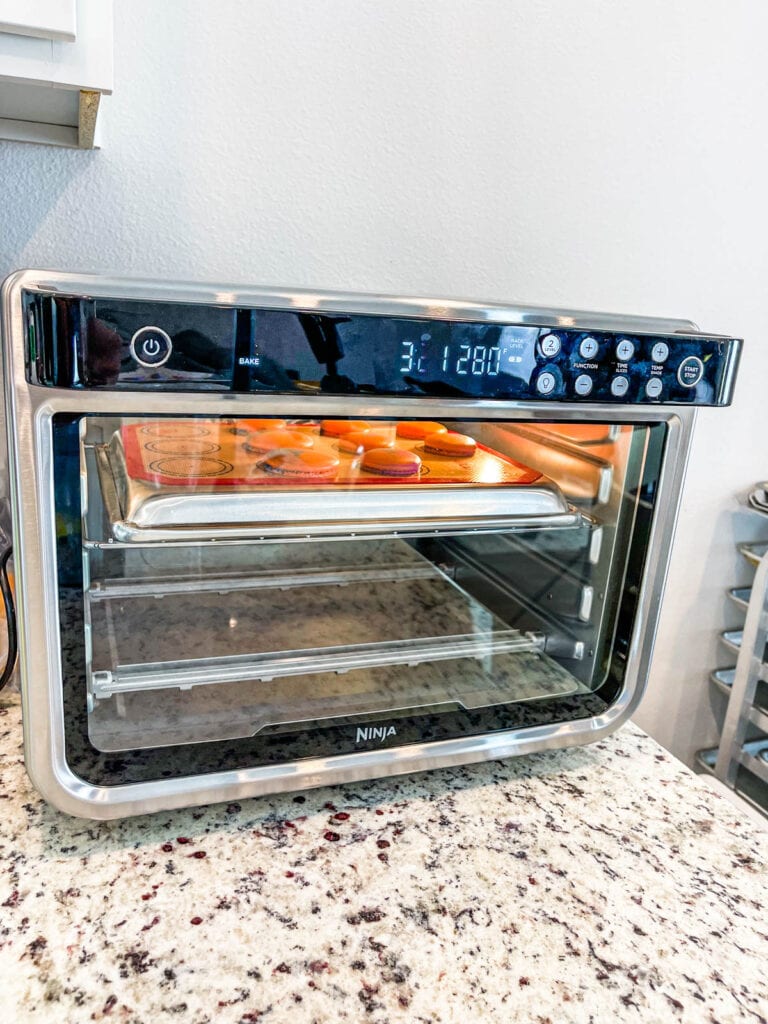
With this oven, I don’t have to rest the macarons (unless they have a LOT of food coloring, in which case I must rest them regardless of the oven or pan I am using).
However, I do notice a difference in the feet. The feet of the macarons that do rest come out taller, and just overall prettier, while the feet of the macarons that don’t rest are a bit smaller.
To do no-rest method, I must use my pans upside down, or use a rimless baking sheet. I have actually transitioned to baking ALL of my macarons with an upside down pan, or rimless baking sheet, because that allows for the heat to circulate better through the macarons, it distributes it more evenly and the overall results are much more consistent.
For the small oven, this is the tray I use, and I just flip it upside down as you can see on the picture above and bake on the back of the tray.
And Teyanna from Whisk ATX teaches a no-rest method with the AirBake pan. The air bake pan is insulated on the bottom, so it heats up slowly, which gives the macarons a chance to dry before they start baking. The air bake pan doesn’t work for my large oven, the feet of the macarons come out as I’ve described before, and if I rest the macarons and bake with that tray, they won’t develop a nice bottom, since there’s too little heat coming in contact with the bottom of the shells. So now I stay away from the air bake pans, but it does work for a lot of folks out there.
These are all things to take into account when choosing the best pan to use, and when choosing to rest or not rest. It’s important to experiment and try new things to see what works. If you already have regular pans, try flipping them upside down and baking on the back of them before investing in new trays, and see how that works.
And again I will repeat the disclaimer from above, if my shells have a lot of food coloring (deep colors such as black, red, vibrant blues, greens) I MUST rest them no matter what oven or pan I am using. If I don’t rest them, they will crack when baking.
Oven Drying Method
Try oven drying the macarons. It is an amazing technique for humid climates. I’ve first heard about this method from Sugar Bean’s YouTube channel. Basically, the technique entails placing the macarons you’ve just piped on a pre-heated oven that has a low temperature (this number will vary from oven to oven, I’d suggest start trying around 230ºF). After you’ve placed the macarons in the low temperature oven, set a timer for 2 minutes, and then increase the temperature to 285ºF (again the number may change depending on your own personal oven/kitchen/experience), and continue baking until the macarons are done.
It won’t work for everyone, and it won’t work for every single oven, and you may have to play around with the temperatures. Some ovens take forever to raise the temperature, which may mean you’ll end up with hollow macarons, or under baked shells, or concave shells, and some ovens are much stronger and more potent, which can mean you’ll have to turn the temperature down a notch from what’s being recommended here.
Regardless, it is a technique worthy of your time and attention, and I recommend you try it out if it sounds like something that could be beneficial to you.
Other tips for baking and keeping macarons at high humidity
- Keep your ingredients covered. If I separate the ingredients much earlier than I am planning on baking, I make sure to cover them tightly so they aren’t in contact with the humid air. Don’t leave the sugar, or anything else exposed to the air for too long.
- There’s a chance your almond flour will absorb humidity from the air, even if the container isn’t open at all times. If you notice your almond flour is clumping together, or just feels generally more humid, you can dry it in the oven. To dry the almond flour, spread it on a baking sheet, and bake it in the pre-heated 200 Fahrenheit oven for about 30 minutes, remove it, let it cool down, and then use it.
- The macarons will be softer, so perhaps jam or curd fillings will make the macarons become soggy faster than if you were in a dry climate. A great way to prevent that is to brush the bottom of the macaron shells with a layer of melted chocolate, or a layer of buttercream, which will form a barrier between the shell and the wet filling.
- Keep the macarons in the container without removing the lid once you take them out of the fridge or freezer, and don’t open the container until the macarons have come to room temperature, this will prevent “sweating” of the shells.
- But if the shells do have condensation, not to worry, it should evaporate soon, just let the macarons be for a while and wait. It’s best not to touch the shells at this point, because they will be sticky for a little bit, but once the macarons come to room temperature, this should go away.
If I had to sum up all the tips into the most important ones, I’d say: get an air conditioner or dehumidifier and use egg white powder.
Those two things would be enough for me to be able to bake macarons with the situation I have going on right now, considering my ovens, kitchen, and climate.
But all the other tips are very valuable and will enhance the quality of your macarons for sure, and perhaps the answer to your problems really is drying the almond flour, or changing your oven, or going for a no-rest method. Again, it all works differently for everyone when it comes to macarons, I can offer the knowledge I have, and what works for me based on my personal experiences, and on what I see people reporting to me day in and day out, but it’s up to you to find out which of these will personally apply to your own macaron baking.
For more macaron articles and a plethora of knowledge, tips, and tricks, click here to visit Macaron School.





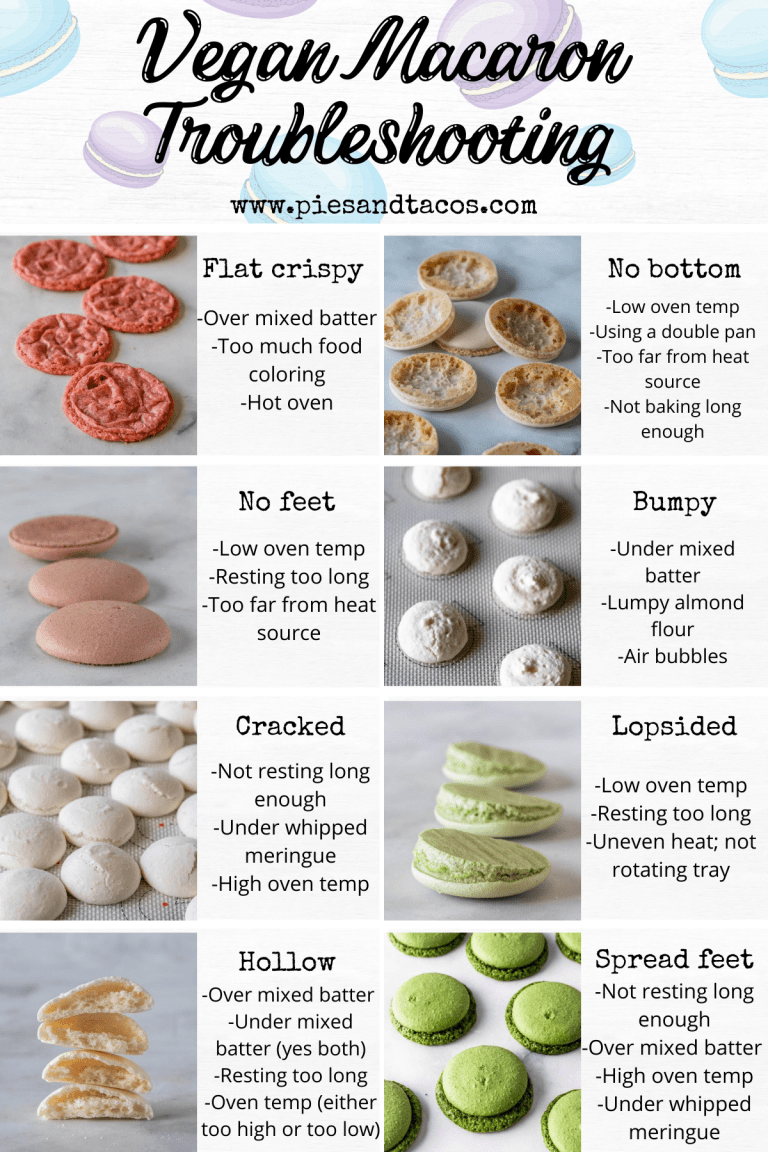
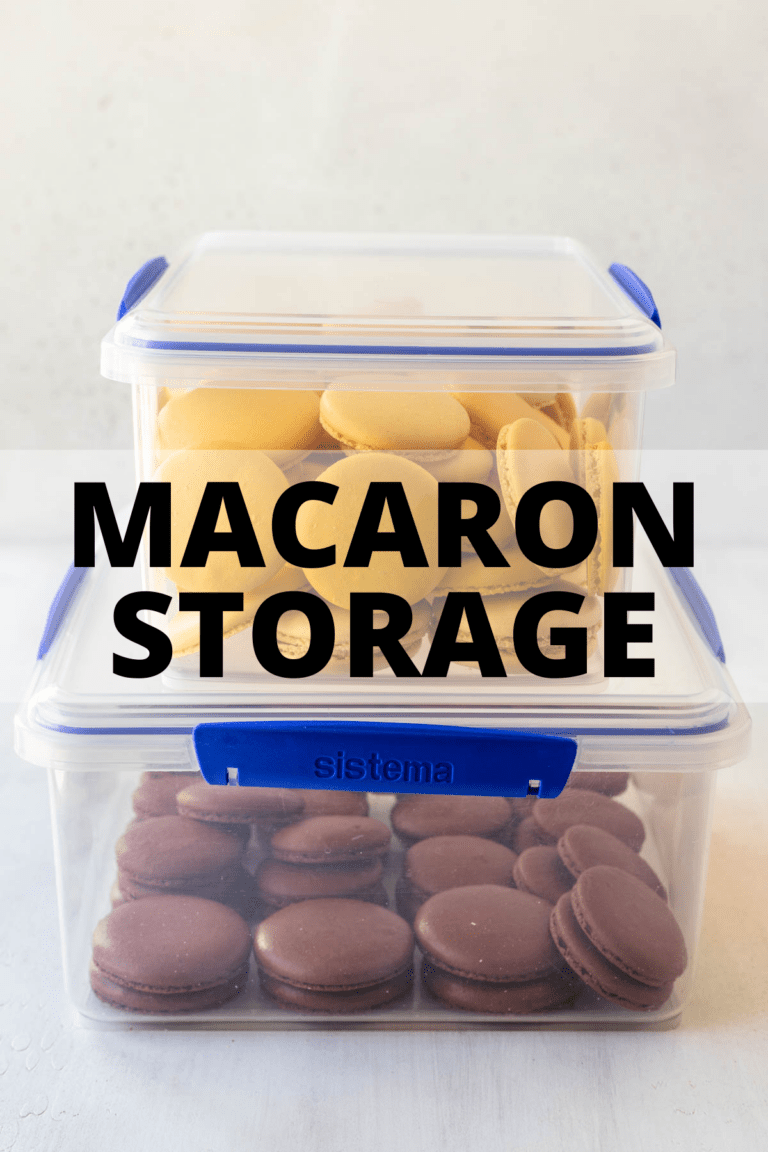
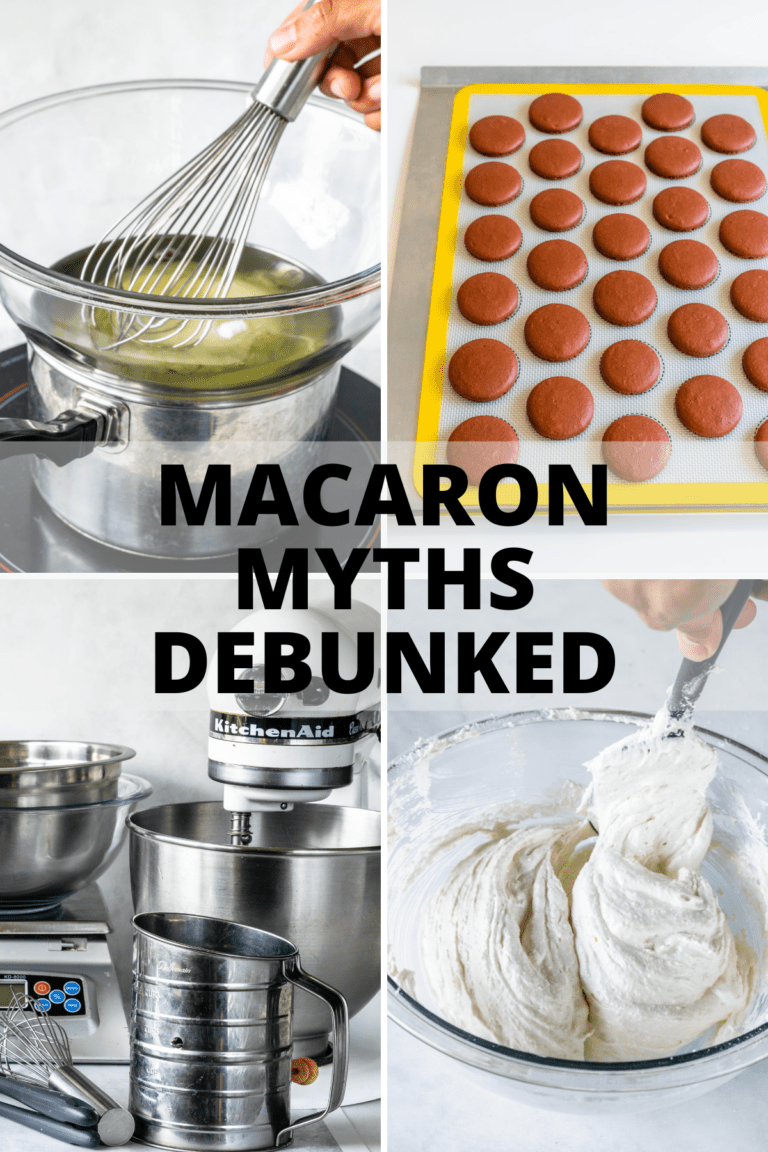
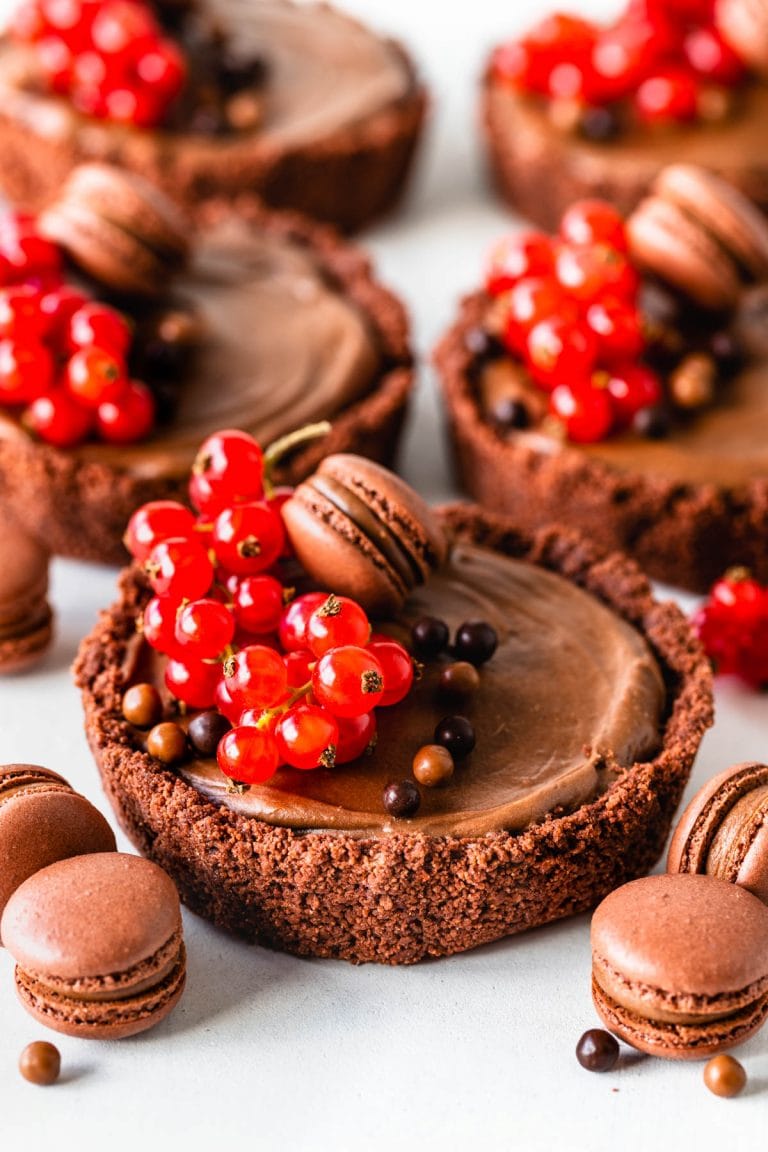
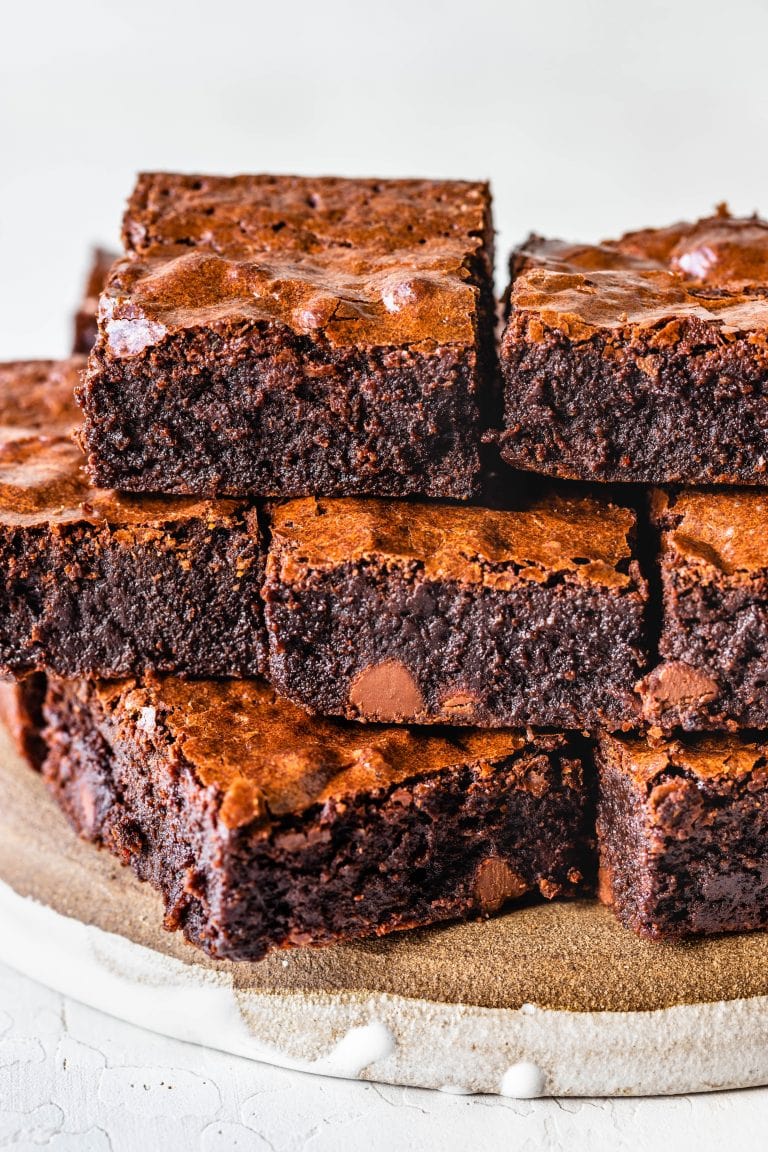
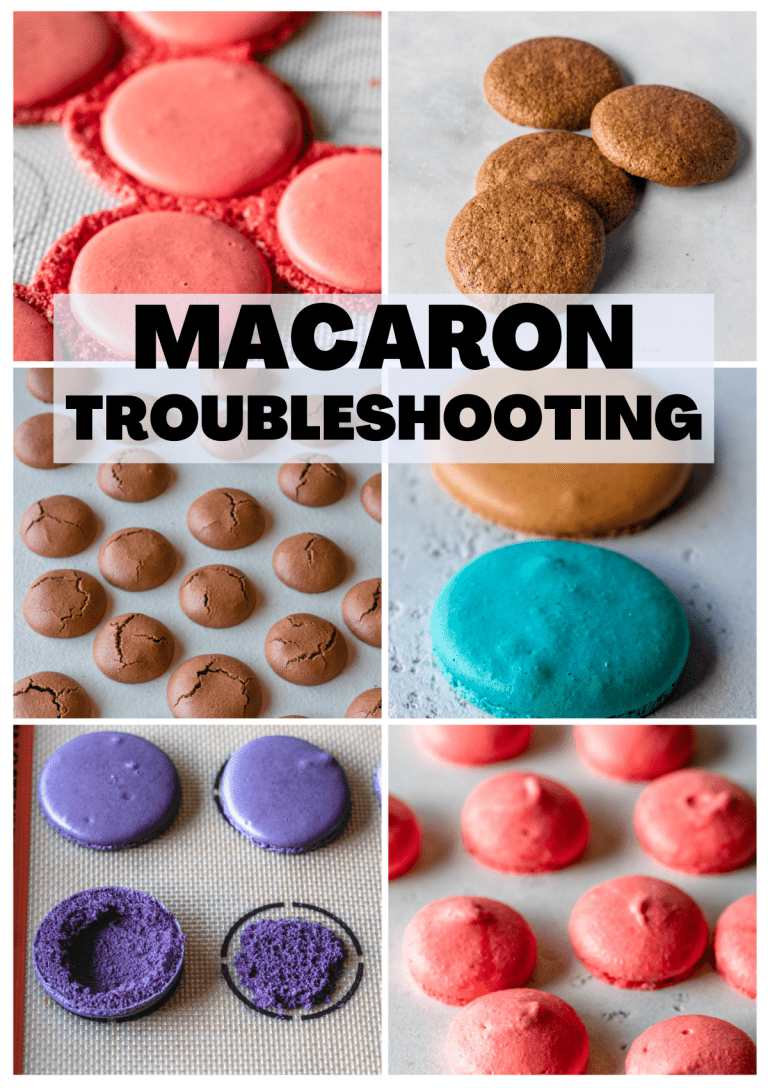
Muito instrutivo, obrigado!!!!!
Obrigada 🙂
Thank you, Camila! It’s very helpful!
Hello Camila,
Do you happen to have a buttercream recipe that you’d be willing to share that can pass the cottage law process? I know each state has different requirements but I think they have to be somewhat similar.
I am so sorry but I am not informed about cottage laws enough so I really don’t know what can be used or not!
Hi camilia, when it’s come to sugar. Which is best to make macarons?
Is it castor or granulated sugar?
I use granulated because I melt the sugar with the egg whites before whipping, but if you use french method you might consider using caster sugar because its finer and dissolves more easily during whipping. I have a whole article about sugar here https://www.piesandtacos.comsugar-role-in-macarons/
Hi Camila, I live in Minnesota and at the moment well it’s very cold and inside my home it’s very humid I think, I don’t have something that tells the level of humidity which I will need soon, I usually rest my macs for an hour and by the time an hour has passed they still look shiny and wet, should I increase the rest time?
Yes. Even with my dehumidifier on, I rested mine for like 2 hours yesterday. If your oven supports it, you can try a no-rest method.
I use my hairdryer on hot humid days to dry my macarons
Do you have a humidity thermometer? If so which one and what do you prefer the level to be at in your kitchen that yields the best results?
Thank you!
yes i do have one i keep it in the kitchen. my dehumidifier also tells me the level of humidity when i turn it on
Hi! I just made macarons, and they are almost 2 hours resting and still not dry. How long is the max. time to let them dry? (Humidity 96% here in Belgium and don’t have any of those things in your post to make it dry faster) 😊
Hi! I love your Mac recipe ❤️
What is the ideal humidity level you wait for when baking macarons? Do you try to get it down to 59 before you start?
I really dont wait for any humidity level really, but for me it’s ideal when it’s between 40 and 50% just as far as drying the shells faster before baking.
Hello! I have an opposite question to your article! How do I prevent my macarons from getting hard and crunchy during the dry season? I currently use cream of tartar so I assume take that out. Any other suggestions?
Cream of tartar doesnt usually make my macarons dry or crunchy, egg white powder does. But you can try without the cream of tartar and see how it is the texture without it. But I really recommend adjusting the baking time, making sure it doesnt get over baked. maybe check more often to see if its baked.
Thanks for all the tips! I lived in the states for 36 yrs, no problem at all now I retired here in the Philippines, the humidity is really disappointing… taste is good but the appearance is ugly!🤦♀️ it’s so expensive here and I wanted to spoil my family and friends by baking all the time! Thanks for sharing all the tips!